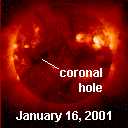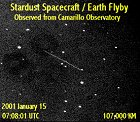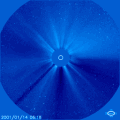|   SPACE WEATHER SPACE WEATHER
Current
Conditions
Solar Wind
velocity: 336.7 km/s
density:4.7 protons/cm3
explanation | more data
Updated: Today at 2246 UT
X-ray Solar Flares
6-hr max: C1 1955 UT Jan16
24-hr: C2 1530 UT Jan16
explanation | more data
Updated: Today at 2245 UT
Daily Sun: 16 Jan '01 
Sunspot group 9306 exhibits a complex beta-gamma magnetic field that likely harbors energy for M-class solar flares.
Sunspot Number: 154
More about sunspots
Updated: 15 Jan 2001
Radio Meteor Rate
24 hr max: 30 per hr
Listen to the Meteor Radar!
Updated: 16 Jan 2001 Interplanetary Mag. Field
Btotal: 6.9 nT
Bz: 5.1 nT south
explanation | more data
Updated: Today at 2247 UT Coronal Holes:

A small coronal hole is rotating toward the center of the Sun's disk. It could send a gust of solar wind toward Earth later this week. Image credit: Yohkoh Soft X-ray Telescope.
More about coronal holes
 SPACE WEATHER SPACE WEATHER
NOAA
Forecasts
Solar Flares: Probabilities for a medium-sized (M-class) or a major (X-class) solar flare during the next 24/48 hours are tabulated below.
Updated at 2001 Jan 16 2200 UT
| FLARE | 24 hr | 48 hr | | CLASS M | 50 % | 50 % | | CLASS X | 05 % | 05 % |
Geomagnetic Storms: Probabilities for significant disturbances in Earth's magnetic field are given for three activity levels: active, minor storm, severe storm
Updated at 2001 Jan 16 2200 UT Mid-latitudes | 24 hr | 48 hr | | ACTIVE | 25 % | 20 % | | MINOR | 05 % | 05 % | | SEVERE | 01 % | 01 % |
High latitudes | 24 hr | 48 hr | | ACTIVE | 30 % | 25 % | | MINOR | 10 % | 10 % | | SEVERE | 01 % | 01 % |
| What's Up in Space -- 16 Jan 2001
Subscribe to Space Weather News!  STARDUST FLYBY: NASA's Stardust spacecraft raced past Earth on January 15th (1115 UT) for a gravity assist maneuver en route to Comet P/Wild 2. Observers in California, Hawaii, and Australia reported telescopic observations of the spacecraft, which brightened to 9th magnitude by some estimates. John Rogers (Camarillo Observatory) captured several images of Stardust during the flyby, including this 60 second exposure of the spacecraft streaking through the constellation Taurus. For more information visit the Stardust Home Page at JPL. STARDUST FLYBY: NASA's Stardust spacecraft raced past Earth on January 15th (1115 UT) for a gravity assist maneuver en route to Comet P/Wild 2. Observers in California, Hawaii, and Australia reported telescopic observations of the spacecraft, which brightened to 9th magnitude by some estimates. John Rogers (Camarillo Observatory) captured several images of Stardust during the flyby, including this 60 second exposure of the spacecraft streaking through the constellation Taurus. For more information visit the Stardust Home Page at JPL.
 BRIGHT CME: A solar filament erupted near the Sun's northwest limb on Sunday, sending this dazzling coronal mass ejection (CME) into space at 744 km/s. The bulk of the CME was clearly directed away from Earth; forecasters do not anticipate substantial geomagnetic disturbances as a result of the explosion. BRIGHT CME: A solar filament erupted near the Sun's northwest limb on Sunday, sending this dazzling coronal mass ejection (CME) into space at 744 km/s. The bulk of the CME was clearly directed away from Earth; forecasters do not anticipate substantial geomagnetic disturbances as a result of the explosion.
WEAK IMPACT: A weak interplanetary shock wave hit Earth's magnetosphere Saturday morning at ~0130 UT. Although conditions at the time were favorable for aurora --namely, the interplanetary magnetic field near Earth was pointing south-- geomagnetic activity remained low. The disturbance was the leading edge of a full-halo coronal mass ejection that billowed away from the Sun on January 10th. WEB LINKS: NOAA FORECAST | GLOSSARY | SPACE WEATHER TUTORIAL | LESSON PLANS | MORE NEWS | BECOME A SUBSCRIBER |
 - TOTAL LUNAR ECLIPSE: On Jan. 9, 2001, the full Moon glided through Earth's copper-colored shadow. [gallery]
- CHRISTMAS ECLIPSE: Sky watchers across North America enjoyed a partial solar eclipse on Christmas Day 2000 [gallery]
- LEONIDS 2000: Observers around the globe enjoyed three predicted episodes of shooting stars. [gallery]
 | NEAR-EARTH ASTEROIDS: MIT's LINEAR asteroid search program spotted another Potentially Hazardous Asteroid on January 2nd: 2001 AD2. The 400m-wide space rock is notable because its low-inclination orbit can bring it close to four planets: Mercury, Venus, Earth and Mars. 2001 AD2's most recent close encounter was with Venus on Oct. 23, 1999, when the asteroid was ~0.01 AU from that planet. It will fly by Earth on Dec. 25, 2001, at a distance of 0.09 AU. If the asteroid's orbit remains substantially unchanged, 2001 AD2 will never come closer to our planet than 3.5 lunar distances. |  Jan. 4, 2001: Earth at Perihelion -- On January 4, 2001, our planet made its annual closest approach to the Sun. Dec. 29, 2000: Millennium Meteors -- North Americans will have a front-row seat for a brief but powerful meteor shower on January 3, 2001. Dec. 28, 2000: Galileo Looks for Auroras on Ganymede -- NASA's durable Galileo spacecraft flew above the solar system's largest moon this morning in search of extraterrestrial "Northern Lights" Dec. 22, 2000: Watching the Angry Sun -- Solar physicists are enjoying their best-ever look at a Solar Maximum thanks to NOAA and NASA satellites. Dec. 18, 2000: Ursid Meteor Surprise -- The normally meek Ursid meteor shower could surprise sky watchers with a powerful outburst on Dec 22nd. Dec. 8, 2000: The Baffling Geminid Meteor Shower -- Most meteor showers are caused by comets, but the Geminids, which peak on December 13th, seem to come from a curious near-Earth asteroid. Nov. 22, 2000: A Solar Flare Stuns Stardust -- Earlier this month an intense solar radiation storm temporarily blinded NASA's Stardust spacecraft en route to comet Wild-2. Nov. 21, 2000: Leonids Galore -- Find out what happened during the 2000 Leonids meteor shower. Nov. 7, 2000: Much Ado about 2000 SG344 -- In 2071 a relic of NASA's earliest space exploration efforts might return to Earth, if current estimates are confirmed. Oct. 26, 2000: Lunar Leonids -- On Nov. 17, 2000, the moon will plow through a stream of debris from comet Tempel-Tuttle. Oct. 10, 2000: The Moonlit Leonids 2000 -- Our planet is heading for a minefield of cosmic dust streams laid down by periodic comet Tempel-Tuttle. The result could be a series of meteor outbursts on Nov. 17 and 18, 2000. MORE SPACE WEATHER HEADLINES |



